2018: The Year in Siren Writing
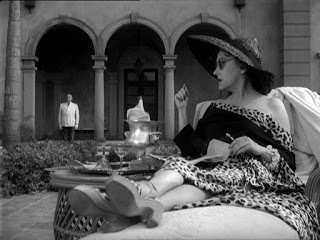
This year has found the Siren doing most of her writing for paying outlets, which endeavors plus the demands of her brood have kept her largely off the blog. For those who haven’t been keeping up with the Siren’s writings, due to exhaustion, distraction, or because Max was polishing the Isotta Fraschini and forgot to turn on the computer, the Siren herewith presents an abridged list of what she was doing in 2018.
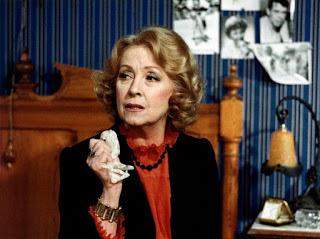 First on the list is something the Siren wrote for the Criterion Collection’s blog, The Current, on the exquisite and irreplaceable Danielle Darrieux. Alas, the very mention of that name brings the Siren to sad news about a friend who loved Darrieux above all others. This year, we lost one of the pillars of the Siren community: X. Trapnel, our own beloved XT, who died suddenly in the fall. He enriched the Siren’s life, and the blog would never have been the same without him. The Siren hopes he is somewhere meeting his beloved Mme. Darrieux at last.
First on the list is something the Siren wrote for the Criterion Collection’s blog, The Current, on the exquisite and irreplaceable Danielle Darrieux. Alas, the very mention of that name brings the Siren to sad news about a friend who loved Darrieux above all others. This year, we lost one of the pillars of the Siren community: X. Trapnel, our own beloved XT, who died suddenly in the fall. He enriched the Siren’s life, and the blog would never have been the same without him. The Siren hopes he is somewhere meeting his beloved Mme. Darrieux at last.By the time Darrieux was sixty-five, she had long since grown into an ineffable serenity and elegance, not just foreigners’ ideal of a Frenchwoman, but the French ideal as well. The first glimpse of her in Demy’s sung-through musical Une chambre en ville comes in black-and-white, like an echo of Darrieux’s past as well as the character’s. From the window of her spacious apartment an annoyed Madame Langlois is looking down on a worker’s demonstration. She can see her handsome young tenant, François Guilbaud (Richard Berry), in the front line facing down a vast army of police. Madame Langlois takes his presence among the strikers, as she takes many things, as a sign of terrible manners.
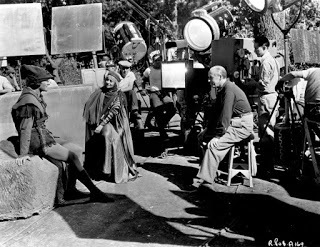 Not online: The Siren’s enthusiastic Sight & Sound review of
Michael Curtiz: A Life in Film
, by Alan K. Rode. If you need a last-minute Christmas gift for someone who loves classic film and/or Hollywood history, this would be an excellent choice — at more than 400 pages, it reads as swiftly and enjoyably as any biography the Siren has read, and she has read an inordinate number of such books, as her patient readers know.
Not online: The Siren’s enthusiastic Sight & Sound review of
Michael Curtiz: A Life in Film
, by Alan K. Rode. If you need a last-minute Christmas gift for someone who loves classic film and/or Hollywood history, this would be an excellent choice — at more than 400 pages, it reads as swiftly and enjoyably as any biography the Siren has read, and she has read an inordinate number of such books, as her patient readers know....Curtiz also “worked people to death,” remarked Wax Museum’s Glenda Farrell, who still liked the director, although many (perhaps even most) of his actors did not. Early on, Rode drily remarks that Curtiz, “more than any other studio director… was responsible for the founding of the Screen Actors Guild.” Curtiz thought lunch was for sissies and until groups like SAG began to pester him, the director appeared to think going home and sleeping were dispensable luxuries as well. By the time Curtiz’s career was in full flower, and he was beginning his 12-film association with Errol Flynn, the director had settled down a bit, but not much, and the easygoing Flynn grew to detest the man who unquestionably did the most to make him a star. So did Flynn’s frequent co-star Olivia de Havilland. Yet all his life, Curtiz maintained a great ability to spot talent (he was an early booster of both Doris Day and the great John Garfield, to name just two) and a knack for drawing out a great performance…
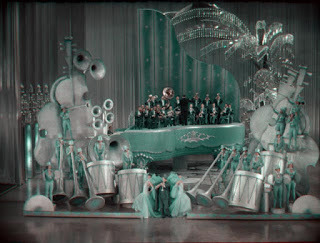 The booklet essay for Criterion’s Blu-Ray release of King of Jazz. In 1930, the daring and ill-fated Carl “Junior” Laemmle put his chips on two big projects. One you perhaps have heard of, a trifle called All Quiet on the Western Front. The other was this extravagant two-strip Technicolor revue, an attempt to make a movie star of the portly bandleader Paul Whiteman. (Includes bonus sideswipe of Mordaunt Hall.)
The booklet essay for Criterion’s Blu-Ray release of King of Jazz. In 1930, the daring and ill-fated Carl “Junior” Laemmle put his chips on two big projects. One you perhaps have heard of, a trifle called All Quiet on the Western Front. The other was this extravagant two-strip Technicolor revue, an attempt to make a movie star of the portly bandleader Paul Whiteman. (Includes bonus sideswipe of Mordaunt Hall.)In the end...production delays cost the movie more dearly than anyone could have foreseen. By the time King of Jazz made its bow, Hollywood had indulged its eternal tendency to run a trend into the ground, and revues were such a drug on the market that some other musicals were being advertised with taglines like “Positively not a revue!” There was also the little matter of what happened on Wall Street on October 29, 1929. The worst of the Great Depression was in the future, but the effects of the crash were already being felt.
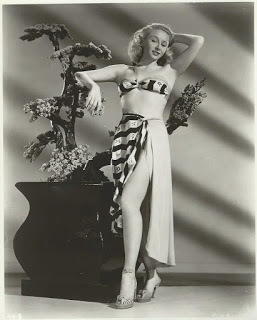 The Museum of Modern Art showed a two-part series of splendid restorations of films from Republic Pictures, and the Siren wrote about them both for the late and very much lamented Village Voice.
The Museum of Modern Art showed a two-part series of splendid restorations of films from Republic Pictures, and the Siren wrote about them both for the late and very much lamented Village Voice.There was one way to get [legendarily cheap Republic studio boss Herbert] Yates to pry open his checkbook, however, and that was to put Vera Hruba Ralston in the leading role. Vera Hruba was a former Olympic ice skater with a lithe and athletic figure, a face the camera liked only intermittently, and a Czech accent that no amount of coaching could diminish. When Yates met his version of Citizen Kane’s Susan Alexander, a girl fully forty years his junior, he was married with two kids. He signed Ralston to a contract in 1943, and thereafter this otherwise hard-nosed and entirely unromantic man spent every last one of his remaining studio years engaged in a fruitless effort to make Ralston a star, meantime divorcing his wife in 1948 and marrying Vera in 1952. Yates gave Ralston — billed variously as Vera Hruba, Vera Ralston, and Vera Hruba Ralston — his best scriptwriters, directors, and co-stars. For years, according to Scott Eyman, Yates bought the full back-page ad space at Variety and the Hollywood Reporter just for the opportunity to run a photo of Ralston with the caption, “The World’s Most Beautiful Woman.” It was rather touching, as even Yates’s frustrated employees would sometimes admit, but it was all for naught.
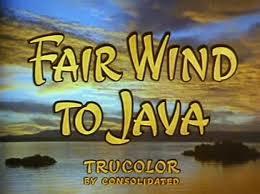
Part two, or as the Siren likes to call it, Republic Rides Again:
Then there’s Fair Wind to Java (1953), described by at least one critic as “the ultimate B-picture” (and once you’ve seen it, that’s hard to dispute). Vera Hruba Ralston often cited Fair Wind as her favorite movie. The Czech former figure skater’s casting as a Balinese dancer named Kim Kim (“My father was white,” the character explains casually) is the strangest in the movie, which is saying something when you have Fred MacMurray as a hard-bitten sea captain named Boll… Scorsese has often spoken of his fondness for Fair Wind — and indeed, it is hugely enjoyable in its crazy way, graced by an eye-searing Trucolor palette, barreling plot developments, indifference to plausibility, and dialogue like “It’s a little island called Krakatoa. No one’s ever heard of it!”
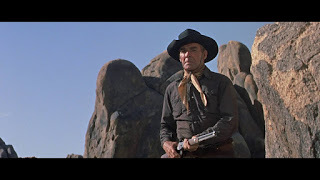 Not online: An essay included in the British company Powerhouse's lavish Blu-Ray box set of Budd Boetticher films. The Siren notes, also for purposes of Christmas or other holiday giving or just plain old self-care, that this set is region-free. She wrote the essay for Comanche Station.
Not online: An essay included in the British company Powerhouse's lavish Blu-Ray box set of Budd Boetticher films. The Siren notes, also for purposes of Christmas or other holiday giving or just plain old self-care, that this set is region-free. She wrote the essay for Comanche Station.The lonely, high-up opening view of Randolph Scott on a horse, the only thing moving among the stones of the Alabama Hills, isn’t what establishes the valedictory mood of Comanche Station. No, it’s the slant of the sun. The light’s intensity has lessened and the shadows have lengthened. It’s late in the day— for the characters, for the series of movies Scott had made with director Budd Boetticher, for Scott’s career, for the classic Western itself.
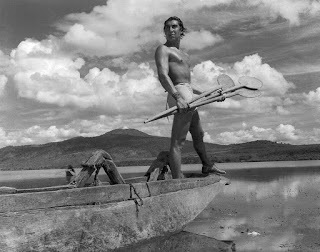 Again for the Voice (lord, how the Siren misses it), an article tied to MoMA's big retrospective of the films of Emilio Fernández, a great Mexican director whose reputation in this country more than deserves to be revived.
Again for the Voice (lord, how the Siren misses it), an article tied to MoMA's big retrospective of the films of Emilio Fernández, a great Mexican director whose reputation in this country more than deserves to be revived.In an age when “colorful” was almost part of a director’s CV — from the eyepatches of Raoul Walsh and John Ford to the foreign birthplaces of Fritz Lang and Ernst Lubitsch to the itinerant macho-jobs years of William Wellman — Fernández went the extra mile. He pulled a stint in prison for his part in the failed rebellion, then drifted around the States, spending time (as he told it) as a cowboy in a circus, a salmon fisherman, a licensed pilot, a bartender, and, finally, as an extra in Hollywood, in the late Twenties. There, legend has it, Fernández’s friend, Dolores del Río, had him pose for her husband, the famed art director Cecil Beaton, for what became the Academy Award statuette. Though Fernández became stocky in his later years, one look at his naked torso in Janitzio — a 1935 movie in the series, in which he plays a star-crossed lover in a fishing village — offers pretty powerful evidence. He really does look like a walking Oscar.
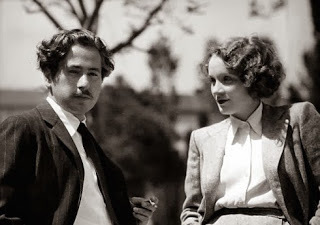 A long and obsessively researched essay on the behind-the-scenes collaborators of Marlene Dietrich and Josef von Sternberg, for Criterion's epic six-disc release "Dietrich and von Sternberg in Hollywood." If you click on no other link in this here post, the Siren hopes you do click on this one, because for the first three months of 2018, she worked her tail feathers off on this one.
A long and obsessively researched essay on the behind-the-scenes collaborators of Marlene Dietrich and Josef von Sternberg, for Criterion's epic six-disc release "Dietrich and von Sternberg in Hollywood." If you click on no other link in this here post, the Siren hopes you do click on this one, because for the first three months of 2018, she worked her tail feathers off on this one.“I never had a better assistant than Miss Dietrich,” the director told one interviewer, with lordly assurance. Still, von Sternberg paid this assistant the tribute of immortality. Other “assistants” went unseen by audiences and are much less frequently discussed. The story of von Sternberg and his colleagues, especially those who never appeared on-screen—the ones who gave dialogue to his characters and shape to his plots, who constructed costumes and sets, the woman whose makeup perfected Dietrich and the men who then lit that glorious face—can be difficult to tease out in part because von Sternberg was almost pathologically incapable of sharing credit. All these artists would have agreed that a von Sternberg film revealed his vision, down to the items on a character’s dressing table and the way Dietrich’s cheekbones were highlighted. But, as Baxter writes, though the director “liked to say he ‘dictated’ the look of his films, dictation is not creation. He needed talented individuals to realize his conceptions.”
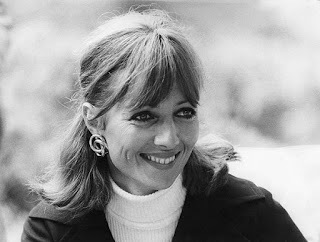 The magnificent Stéphane Audran died in March, and the Village Voice asked the Siren to write a tribute. (Who else will ever do that, now that the Voice is gone? Alas.)
The magnificent Stéphane Audran died in March, and the Village Voice asked the Siren to write a tribute. (Who else will ever do that, now that the Voice is gone? Alas.)If someone asked me to choose the ultimate in Stéphane Audran scenes — not her best or most emotive acting, but a sequence that summed up her talent, her presence — I would choose an early moment in Juste Avant la Nuit (Just Before Nightfall, 1971), directed by her then-husband Claude Chabrol. Her character, Hélène Masson, is in the kitchen of her family’s spectacular modern mansion, baking a chocolate cake with her daughter and the girl’s au pair. She is mixing the batter with a wooden spoon, holding it up from time to time to check whether it has reached the proper consistency. Her posture is erect and graceful as she walks around the room with her bowl, chatting and mixing. Hélène has no apron over her Karl Lagerfeld outfit. There is no need, as Hélène probably has not stained an outfit since her days in lycée. The hard work of baking has touched neither her hair nor her maquillage.
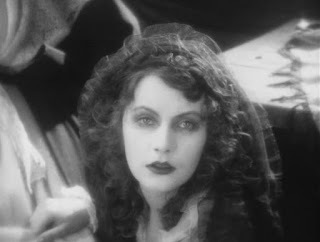 For the San Francisco Silent Film Festival's March shindig, an essay on The Saga of Gösta Berling, a movie the Siren had somehow never seen. She fell in love with it, to the point that she read the Selma Lagerlöf novel. (She recommends the translation by Pauline Bancroft Flach, and not the later Penguin one, which is afflicted by the modern mania for rendering prose as flat, affectless, and literal as possible.)
For the San Francisco Silent Film Festival's March shindig, an essay on The Saga of Gösta Berling, a movie the Siren had somehow never seen. She fell in love with it, to the point that she read the Selma Lagerlöf novel. (She recommends the translation by Pauline Bancroft Flach, and not the later Penguin one, which is afflicted by the modern mania for rendering prose as flat, affectless, and literal as possible.)...From a distance of almost a hundred years, it’s evident that Garbo—only eighteen years old and so beautiful it is said her close-ups made audiences gasp—is just one of many impressive things about Gösta Berling. As the story unfolds, the title’s ex-pastor, played by Lars Hanson, has been defrocked. Gösta’s preaching is so enthralling that his congregation is ready to forgive him for his latest drunken escapade, but then, spurred by idealism and a bridge-burning compulsion that gets him in trouble throughout, Gösta swings into a rousing condemnation of the parishioners’ own chronic boozing. His goose thus self-cooked, he sets out on the road.
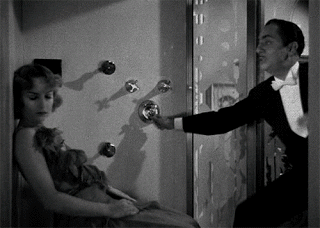 The lovely folks at Criterion asked the Siren to write the booklet essay for one of her most favorite comedies, My Man Godfrey. Which is funny, because the Siren has spent much of the year reading the news and murmuring, "All I have to say is some people will be sorry someday." (Or, if occasion demands, "Life is but an empty bubble.")
The lovely folks at Criterion asked the Siren to write the booklet essay for one of her most favorite comedies, My Man Godfrey. Which is funny, because the Siren has spent much of the year reading the news and murmuring, "All I have to say is some people will be sorry someday." (Or, if occasion demands, "Life is but an empty bubble.")There were hilariously dysfunctional families in American film before and after My Man Godfrey, but the Bullocks of 1011 Fifth Avenue represent peak lunacy. There’s devious Cornelia, played by the darkly beautiful Gail Patrick—“a sweet-tempered little number,” as the maid, Molly (Jean Dixon), calls her. There’s mother Angelica (Alice Brady), whose hangovers include visions of pixies (“I don’t like them, but I don’t like to see them stepped on”), and who is sponsoring a “protégé,” Carlo (Mischa Auer). Carlo’s sponsored talents—the ones that could be shown under the Production Code, anyway—involve a lugubrious rendition of the Russian folk song “Ochi chyornye,” a remarkable ability to make food disappear, and the single best gorilla impression in the history of American film.
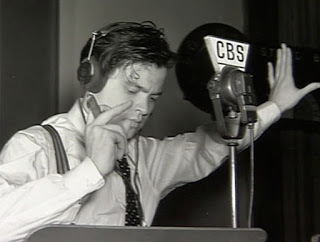 Riffing on a very short thing she once wrote for the blog, the Siren also contributed an essay to Criterion's lavish Blu-ray for The Magnificent Ambersons. The Siren was happy to have the opportunity to praise "The Voice of Orson Welles" at greater length.
Riffing on a very short thing she once wrote for the blog, the Siren also contributed an essay to Criterion's lavish Blu-ray for The Magnificent Ambersons. The Siren was happy to have the opportunity to praise "The Voice of Orson Welles" at greater length.Welles was marked from the beginning by his prodigal gifts, speaking in complete sentences at age two, supposedly analyzing Nietzsche by age ten, performing Shakespeare in his teens, staging the landmark “Voodoo Macbeth” at age twenty—and yet the role his voice played in his spectacular youthful ascent isn’t analyzed often. That preternaturally mature instrument helped enable the orphaned sixteen-year-old and rather baby-faced Welles to literally talk his way into roles with Dublin’s Gate Theatre. Listen to the talk of an average teenage boy, even one who’s an actor, and ask yourself if anyone in their right mind would cast him in a commercial stage production as the evil Duke of Württemberg in Jew Süss, Welles’s first role at the Gate.
 Rounding out a good year, assignment-wise, the Siren sang the praises of the eternally beautiful 7th Heaven for the San Francisco Silent Film Festival's Day of Silents.
Rounding out a good year, assignment-wise, the Siren sang the praises of the eternally beautiful 7th Heaven for the San Francisco Silent Film Festival's Day of Silents. While Borzage was still preparing 7th Heaven, F.W. Murnau had arrived at Fox in 1926 to much fanfare and was filming his masterpiece, Sunrise, a production that continued even after Borzage’s film began shooting. (In an incredible feat of endurance, for a short period of time in January 1927, Janet Gaynor was shooting Sunrise exteriors for Murnau by day and returned to the Fox studio at night for 7th Heaven.) The German master’s presence exerted an influence on nearly everyone in the studio. Many critics have noted that certain 7th Heaven camera movements, such as the shot that follows Nana pursuing Diane into the street (achieved, Palmer recalled, by having eight men carry an eight-by-eight platform on which the cameraman rode with his tripod), bear Murnau’s influence. But Borzage’s emotional effects were entirely his own.
Published on December 19, 2018 06:38
No comments have been added yet.
Farran Smith Nehme's Blog
- Farran Smith Nehme's profile
- 27 followers
Farran Smith Nehme isn't a Goodreads Author
(yet),
but they
do have a blog,
so here are some recent posts imported from
their feed.



